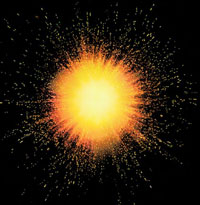A team from the Technion succeeded in reconstructing with a powerful laser the moment of the creation of the universe, 13 billion years ago

Prof. Polturk's team won a secret competition to reconstruct the Big Bang, which was conducted between several research groups from Germany, Italy, France and Portugal. "Their soccer teams beat Israel, but in the laboratory we were the first," Prof. Polturk testifies to his majesty.
In the experiment, which was designed by the doctoral student Ariel Maniv, a powerful laser was built that is capable of heating and cooling matter at tremendous speed. The researchers created a superconducting fuse from a mixture of the chemical elements barium, copper, yttrium and oxygen. A thin layer of the material was placed on a special substrate, which was heated to a very high temperature, and immediately cooled to minus 200 degrees. The cooling rate reached 100 million degrees in one second. ''It was like throwing a hot iron into an ice bath,'' says Prof. Polturk.
The temperature change (phase change) created about 30 tiny magnets, which were picked up by a highly sensitive sensor. The strength of each of the magnets was one millionth the strength of the Earth's magnetic field. The creation of the magnets corresponded to the theory first put forward, about 18 years ago, by the Polish-born astrophysicist Weytch Zorek, from the Los Alamos Laboratory in the United States. Zork pointed out that phase transitions that are identical in nature exist not only in space (and happened in the bang) - but also on Earth, and therefore it is possible to reconstruct the big bang.
The experiment was designed to examine which elementary particles - the building blocks of all matter in the universe - were created following the big bang, when space was filled with a fiery and undefined "soup" of concentrated energy and enormous radiation. The particles only formed when the cooling began. But why did these particles form and not others? Why are they all the same? Why were protons and not anti-protons (particles with opposite electric charge) created? Why is there no particle consisting of only half a proton?
The experiment, which the scientists in Haifa repeated several times, revealed that the nature of the particles created in the Big Bang was just a matter of luck. In the same way, Prof. Polturk emphasizes, others could have been created - and all the material in the universe, which makes up the stars, planets and even my son - man was different.
A report on the scientific achievement was given at international conferences held recently in Spain and Italy. "We stole the show when we demonstrated what we did in Haifa with such a meager budget," says Prof. Polturk.
